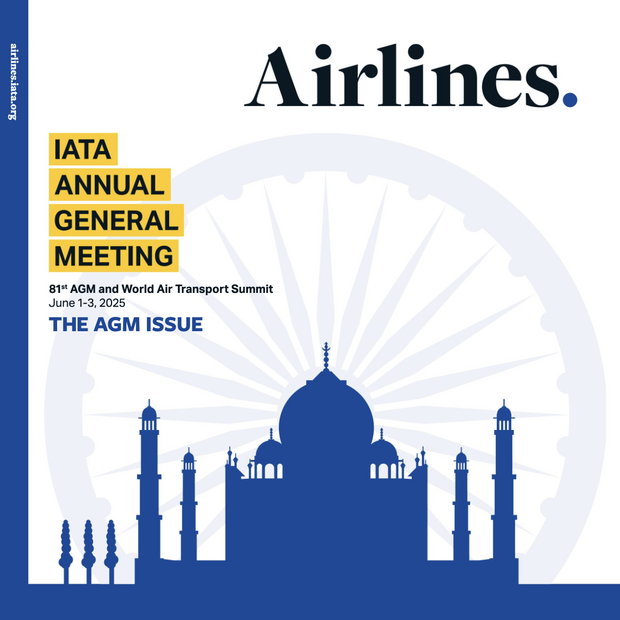
Good morning.
It’s a pleasure to welcome you to the 16th IATA World Cargo Symposium. I want to extend my thanks to Turkish Airlines for hosting this event.
As we gather in this magnificent city that links two continents, we are reminded of its rich heritage as a center of commerce and trade, and the role it has played in shaping the global trade landscape that we have today.
However, it is with a heavy heart that we remember the devastating earthquakes that have struck the country recently. Our thoughts and condolences go to all those affected by this tragedy.
We can take some solace in the knowledge that air cargo has provided much-needed assistance and relief to those impacted by this disaster through the timely delivery of aid and essential medical supplies.
So where are we today?
We are a different industry than the one that entered the pandemic. Revenues are greater than they were pre-pandemic. Yields are higher. The world learned how critical supply chains are. And the contribution of air cargo to the bottom line of airlines is more evident than ever.
Yet, we are still linked to the business cycle and global events. So, the war in Ukraine, uncertainty over where critical economic factors like interest rates, exchange rates and jobs growth are headed are concerns that are real to the business today.
But they are also ones that we have long experience in dealing with. And they are offset with some certainties:
- The middle class continues to grow---if more slowly than pre-pandemic
- High value goods and pharmaceuticals need to get to people quickly
- And e-commerce is growing at around 10% per year.
- Complementing these growth drivers are the efficiencies the industry realized during the pandemic from accelerating digitalization.
Priorities
As we navigate the current situation, air cargo’s priorities have not changed. We need to continue to focus on:
- Sustainability
- Digitalization
- And safety
Sustainability
Sustainability is our industry’s license to do business and a critical priority. That is not just for air cargo. It is for all of aviation. That’s why we have committed to net zero carbon emissions by 2050. And in October last year, governments have come on board with the Long-Term Aspirational Goal (LTAG) agreed at the 41st ICAO Assembly. Governments now share the same aim. And that should provide critical policy support.
The most critical area is Sustainable Aviation Fuel (SAF). We estimate that 65% of carbon abatement will come from SAF. SAF is being produced. And every single drop is being used. The problem is that the quantities are small. The solution is government policy incentives.
Through incentivizing production, we could see 30 billion liters of SAF available by 2030. That will still be far from where we need to be. But it would be a clear tipping point towards our net zero ambition of ample SAF quantities at affordable prices.
While we increase SAF production, we know that many shippers, customers, and regulators want immediate carbon-neutral shipping options or assurances that we are operating our businesses as sustainably as possible. I am pleased to report progress in four key areas that could meet this need:
- First is progress to support effective CO2 emissions calculations for air cargo, with accurate and standardized emissions calculation methodology. This responds to the growing demand for CO2 data transparency linked to airline-specific data and actual fuel burn. CO2 Connect for Cargo will be powered by actual airline operational data and based on the industry-approved methodology RP1678.
- Second is IEnvA for Cargo. Expanding the IATA Environmental Assessment to airports, cargo handling facilities, freight forwarders, and ramp handlers will allow the industry to drive commercial success, build trust in our sustainability actions, and positively impact the industry.
- Third is environmental, social and governance (ESG) related metrics. IATA is cutting through the many methodologies in circulation with ESG Metrics Guidance for Airlines. This guide will be launched soon and will be updated regularly to keep pace with this rapidly evolving landscape.
- And lastly, I'm proud to report that the cargo industry is reducing waste generated across the cargo supply chain, including plastic waste. American Airlines, Lufthansa, WFS, and others are moving towards the use of less-harmful plastics, while other stakeholders are aiming to reduce all plastic in their operations, such as LATAM and ANA Cargo.
Digitalization
In addition to specific efforts on sustainability, like any business air cargo needs to continuously improve its efficiency. And the area with greatest potential is digitalization.
We have three goals:
First – 100% airline capability of ONE Record by January 2026
This initiative will replace the many data standards used for transport documents with a single record for every shipment. The Cargo Services Conference agreed on Sunday agreed that it wants to achieve 100% airline capability by 1 January 2026 and the Cargo Advisory Council supports this vision. And IATA will do everything in its power to facilitate that.
Second - Ensuring digital standards are in place to support the global supply chain
We have finalized standards on tracking devices – the IATA Interactive Cargo guidelines - used to monitor the quality and accuracy of conditions of time and temperature sensitive goods being shipped across the world. And our participation in the European Commission’s project “FEDeRATED” is reaching completion after a 5-year development of interoperable technologies and data architectures for use in multi-modal transport.
Third - Ensuring compliance and support for customs, trade facilitation and other government processes that are increasingly digitalized
The modernization agenda also includes governments. A lot of work has been done by nations to agree on and to evolve strategies for trade facilitation, reduce operational barriers at borders and to manage the flows of goods securely. Digitalization plays an important role here. One example is IATA’s work supporting the roll out of the EU’s new Pre-Loading Advance Cargo Information (PLACI) System. PLACI went live on 1 March 2023 despite 12 European States not being ready and not having given definitive information about their timelines for readiness. We are working with these states to provide the necessary clarity to enable airlines to adapt their own implementation planning.
These are big projects. And they are pushing us in the right direction. But we need to move these forward even as the operating environment becomes more challenging.
Safety
Alongside sustainability and efficiency is safety. And here the agenda for air cargo continues to be dominated by lithium batteries.
The first priority is to stop rogue shippers. A lot has been done. But, quite honestly, it is still not enough. Civil aviation authorities must take strong action against shippers not declaring lithium batteries in cargo or mail shipments. And all governments need to support ICAO’s efforts to strengthen the standards in Annex 18 – The Safe Transport of Dangerous Goods.
So, we still need counter measures in case improperly packaged shipments do get on board. Here we are engaging with EASA and FAA to develop a test standard for fire-resistant aircraft containers with a fire involving lithium batteries. The aim is for ULDs to contain a lithium battery fire for up to six hours.
We have made progress on the specific challenge of handling lithium battery powered vehicles. From 1 January 2025 we will have a single standard to identify all such vehicles including vehicles such as hover boards, e-scooters and e-bikes, as well as traditional passenger vehicles throughout the transport process.
And, more broadly, the CEIV Lithium Battery program continues to grow, with 31 companies now certified. These encompass the supply chain with a mix of airlines, freight forwarders, cargo handling facilities and shippers. Having seen the success of CEIV in promoting better transport of pharmaceuticals, fresh products, and live animals, we can be confident that the growth of this program will raise the bar for high quality and safe transport of lithium batteries for all participants in the supply chain.
And one last point that I would like to make on the topic of safety is the progress that we have made in joining dangerous goods shipping data to the rest of the air cargo operation. We just released Connect API to link DG AutoCheck data with operational and back-office functions. This will improve speed, efficiency and safety.
People
Before closing I would like to focus on people.
Unfortunately, thousands of cargo handler jobs were eliminated during the pandemic and there are still staffing challenges.
In a recent industry survey 34% of cargo professionals told us that they foresaw staffing gaps till the end of 2023 and 57% felt that they did not have enough qualified staff to provide smooth operations.
Additionally, more than a quarter (27%) of respondents told us that there is a significant risk that existing staff will not stay with the organization for long.
Post pandemic we need to improve our competitiveness as an employer by:
- Looking to automation to eliminate difficult and hazardous tasks, ensuring that our employees can focus on more engaging, value-added roles.
- Fostering a culture of continuous learning and growth, so we can empower our employees with opportunities for professional development and career advancement
We also need to continue with programs that will attract people to air cargo and keep them here by making them feel proud to be employed in this industry. Specifically,
- The Future Air Cargo Executive (FACE) program which is open to all air cargo / logistical employees under 35 and provides a specific summit for this next generation as part of the annual IATA World Cargo Symposium.
- And the IATA 25 by 2025 initiative to promote equal gender opportunities and highlight the industry’s commitment to woman in leadership. So far 190 airlines have joined this including nine dedicated cargo carriers.
By embracing these changes, we can transform the air cargo industry into a more attractive and competitive employment sector, ensuring our ability to excel in the global market for years to come.
Conclusion
I will bring my remarks to a close by reflecting on why we are all here today. Air cargo is a critically important industry. We should always be guided by that fact.
Our work is helping build a better future for the people of the world. We are in an industry that saves lives, delivering aid and relief to those in need. The industry mobilized to support those affected by the earthquakes in Syria and Türkiye.
While there is no comprehensive tabulation, a limited review of 29 key carriers serving the Türkiye market revealed over 3,500 tons of relief was delivered from over 90 countries and 350 relief and repatriation flights were operated to affected areas.
We must work together to ensure that air cargo remains a reliable and efficient means of providing support to those in need, while simultaneously strengthening our global supply chains and contributing to the sustainable development of our economies.
Let’s keep that in mind as we navigate the many challenges of our business and drive change needed for a strong future.
Finally, I wish you a successful conference.
Thank you

